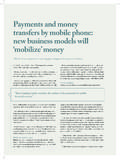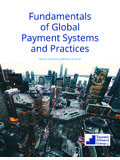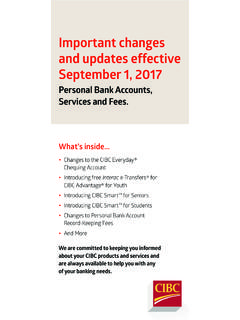Transcription of Mobile Money for Financial Inclusion - World Bank
1 61 Mobile Financial services are among the mostpromising Mobile applications in the devel-oping World . Mobile Money could become ageneral platform that transforms entire economies, as it isadopted across commerce, health care, agriculture, andother sectors. To date, at least 110 Money Mobile systemshave been deployed, with more than 40 million users. Themost well-known system, M-PESA, started in Kenya and isnow operational in six countries; it has 20 million users whotransferred $500 million a month during thebenefits of Mobile Money payment systems are clear,observers remain divided over whether Mobile moneysystems are truly fulfilling their growth chapter evaluates the benefits and potential impact ofmobile Money , especially for promoting Financial inclusionin the developing World , before providing an overview of thekey factors driving the growth of Mobile Money services.
2 Italso considers some of the barriers and obstacles hinderingtheir deployment. Finally, it identifies emerging issues thatthe industry will face over the coming years. Mobile Money : an ecosystemapproachAt the most basic level, Mobile Money is the provision offinancial services through a Mobile device (box ).2 Thisbroad definition encompasses a range of services, includingpayments (such as peer-to-peer transfers), finance (such asinsurance products), and banking (such as account balanceinquiries). In practice, a variety of means can be used suchas sending text messages to transfer value or accessing bankaccount details via the Mobile internet (figure ). Special contactless technologies are available that allow phones totransfer Money to contactless cash registers. Although Mobile phones are central to all these uses, Mobile Money is more than just technology it needs acash-in, cash-out infrastructure, usually accomplishedthrough a network of cash merchants (or agents ), whoreceive a small commission for turning cash into electronicvalue (and vice versa).
3 Because the Mobile Money industry exists at the inter-section of finance and telecommunications, it has a diverseset of stakeholders, with players from different fields incompetition. Mobile network operators, banks, and increas-ingly new entrants, such as payment card firms, continue tocatalyze the industry with innovative offerings, but to besustainable, these must be met with sufficient demand fromconsumers and firms a variable missing in many host of supporting businesses, such as agents and liquid-ity management firms, are also necessary. In areas where ithas proved successful, Mobile Money has created a platformfor start-ups to build upon (Kendall et al. 2011). Finally, allof this must happen in an environment with appropriategovernment regulations for both finance and the ICTC hapter 4 Mobile Money for Financial InclusionKevin Donovansector, as well as appropriate safeguards for Financial Inclusion imperativePoverty is more than just a lack of Money .
4 It involves a lackof access to the instruments and means through which thepoor could improve their lives. Exclusion from the formalfinancial system has increasingly been identified as one ofthe barriers to a World without poverty. In many develop-ing countries, more than half of households lack anaccount with a Financial institution, while small firmsfrequently cite difficulty in accessing and affording financ-ing as a key constraint on their growth. This exclusiondoes not necessarily mean that the poor lack active finan-cial lives: in fact, the fragility of their situation has led tothe development of sophisticated informal financialinstruments. However, the use of only informal instru-ments means that the poor are limited in their ability tosave, repay debts, and manage risk responsibly. On amacroeconomic level, these Financial constraints on thepoor can slow economic growth and exacerbate inequality(Demirg -Kunt, Beck, and Honahan 2008).
5 Finding innovative models to extend Financial services tothe poor has now become an urgent challenge. The excite-ment around Mobile Money has arisen in part because it iswidely seen as an effective way to provide access to finance tomillions of people around the globe. According to theConsultative Group to Assist the Poor (CGAP), roughly 1 billion people have a Mobile phone but no bank them access to Mobile Financial services will involvedifficult implementation that is unlikely to succeed quickly. In addition to extending Financial services to the poor, Mobile Money is expected to improve productivity byincreasing the efficiency and lowering the cost of transac-tions, improving security, generating new employmentopportunities, and creating a platform on which other busi-nesses can grow. Mobile Money could transform Financial Inclusion .
6 Where most Financial Inclusion models have employedeither credit-led or savings-led approaches, the M-PESA experience suggests that there may be a third approach focusing on building the payment rails on which a broaderset of Financial services can ride, wrote the authors of onereport (Mas and Radcliffe 2010). As illustrated in the nextsection, while benefits from the simple diffusion of animproved infrastructural rail are significant, even greaterimpact arises because Mobile Money systems can serve as aplatform for additional innovations, whether they be billpayment services that avoid lengthy queue times or morestriking examples such as efficient conditional cash transfersfor drought relief or places where no62 Information and Communications for Development 2012 Mobile phones are multifunctional devices that allow for a variety of communication range from ubiquitous voice and SMS channels to more sophisticated means such as soft-ware applications or web browsers.
7 To be a viable solution for Mobile Money , the channel shouldideally be universally available (including the cheapest Mobile phones) and must be secure. Inpractice, this requirement largely limits Mobile Money to using a standard network service, suchas USSD (Unstructured Supplementary Service Data) or SMS (short message system), or anapplication preloaded on a unique SIM card. Since Mobile operators control both of these chan-nels, they remain essential gatekeepers in deploying Mobile : ; device, many channelsSource:Adapted from Gencer 2011. Figure types of Mobile Financial servicesMobile paymentsincludingPerson-to-person | Government-to-person | Business-to-business Mobile financeincludingCredit | Insurance | Savings Mobile bankingincludingTransactional | Informational Financial infrastructure exists, this type of change is trulytransformational.
8 What is the impact of Mobile Money ?According to data from the GSM Association, most of the100-plus deployments of Mobile Money systems have beenin developing countries, with around half in Africa alone(figure ). Mobile Money systems can be made availablewherever there is wireless phone service, helping to over-come distance, as well as the lack of branch offices in ruralareas (box ). Since Mobile Money is often linked to Financial Inclusion ,it is vital to understand how and under what conditionsmobile Money applications can extend Financial services tothe poor. Support for Mobile Money initiatives from govern-ments, nongovernmental organizations, and the interna-tional development community needs to be justified byassessing the impact on development goals such as financialinclusion, poverty reduction, increased productivity, andrisk management.
9 Although the Mobile Money industry has achieved signif-icant scale in only a handful of countries, a growing numberof studies are establishing its impact in a variety of areas. Itspotential advantages include benefits arising from the inher-ent characteristics of the services; benefits arising organicallyfrom widespread usage and network effects; and benefitsarising from purposeful and innovative applications, eithermade by developers or created by people s uses of mobilemoney benefitsMobile Money is often successful because it is considerablycheaper than other alternatives to cash. In an internationalcomparison of 26 banks, McKay and Pickens (2010) foundthat branchless banking (including Mobile Money ) was 19percent cheaper on average than alternative services. At lowtransaction amounts or for informal Money transferoptions, this difference more than Kenya M-PESA was routinely one-third to one-half as expensive asalternative systems.
10 Lower costs directly translate intomoney the poor can keep in Kenya the amount of moneyremitted increased when transferred using M-PESA compared with traditional forms of remittances. Conversely,where transaction costs are high, as in Botswana where thecost per transaction is a minimum of 8 pula ($ ), mobilemoney has been slow to take Mobile Money can be safer than alterna-tives, including cash. Early studies of M-PESA in low-income areas found that the risk of muggings declined,because cash was less evident. Because it is less visible thancash, Mobile Money also has consequences for privacy andautonomy. Research has found that women are able to havepersonal savings without seeking permission from theirhusbands (Morawczynski 2009), but, of course, this auton-omy holds true for both speed and liquidity of Mobile Money are also keybenefits.















